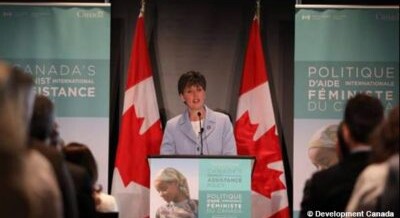
McLeod Group Blog, June 20, 2017
On June 8, Minister of International Development Marie-Claude Bibeau announced Canada’s “first feminist international assistance policy”. It was warmly welcomed by the audience at Global Affairs Canada, composed largely of Canadian civil society organizations that deliver assistance to developing countries. The new policy describes a major focus on gender equality and the rights of women and girls (with a target of 15% of the aid budget, up from 2% currently) and attention to women and girls and gender equality in the five other areas of priority:
- Human Dignity (basic services like health and education)
- Growth that Works for Everyone
- Environment and Climate Action
- Inclusive Governance
- Peace and Security.
While the long-awaited statement is welcome, particularly its feminist content, its omissions, and decoupling from the approaches laid out for foreign policy and defence, raise many questions.
1. Can Global Affairs Canada (GAC), with its current systems and staffing, deliver on this policy? There are two problems with GAC’s current structure and capacity.
First, program and project design, approval and monitoring are notoriously lengthy and bureaucratic processes. Reporting is ritualistic rather than useful and focused on compliance, not development results. Oversight systems are not compatible with the tempo or duration of development processes. For example, a major 2008 evaluation of Canada’s contribution to gender equality through its development cooperation found that it was difficult to identify gender equality results due to inadequate design and faulty monitoring systems. Current systems inhibit the necessary ingredient of outcome achievement: partnership.
Second, the loss of expertise among program staff over the last decade, exacerbated by GAC’s desire for a generalist, rotational approach to specialized jobs like development and its critical gender dimensions, will hamper GAC’s ability to deliver on gender equality. Professional staffing and training in the area of gender equality are currently insufficient to meet international assistance and foreign policy objectives. While Peter Boehm, the Deputy Minister for International Development spoke about “streamlining” GAC systems to expedite implementation, he provided no detail about how this was to be managed, and to what extent lessons from other agencies would be brought aboard. The issue of capacity to deliver requires a major review of existing processes with a gender lens and a feminist perspective.
Becoming fit for purpose will require more than good intentions. It will require major training, new job descriptions, and revised incentives for senior management. Otherwise GAC, instead of applying appropriate analytical tools and receiving sound technical advice related to gender and social analysis, risks falling back on its old formula of “just add women and stir”.
2. What will be the mix of financial and diplomatic tools in GAC’s toolkit? How will GAC ensure coherence among Canada’s multilateral and bilateral domestic and international partnerships (for instance, on maternal, newborn and child health, our work with UNHCR on migration and refugees, or the GAVI Alliance for vaccines) to give priority to gender equality and ensure value for money? Small, village-level projects may sound attractive to Canadians, but they do not replace the need for larger-scale country-led and international efforts that have provided lifesaving immunizations, saved millions from starvation and increased school graduation. The international assistance policy seems aimed more toward supporting Canadian civil society organizations than recipient country-led or multilateral efforts. That may be good for Canadian votes, but less good for development outcomes.
3. Why is the international assistance policy such a stand-alone effort? Successful development cooperation requires coherence among trade, defence, diplomacy and development, as well as consistency with the programs (and expertise) of other ministries, such as health, agriculture, and environment. There has always been a tension between promoting development abroad and protecting narrowly defined Canadian interests. For example, it does no good for women to get jobs in the garment industry in developing countries if Canada imposes tariff barriers on their products. International assistance provided in a timely way can prevent a fragile situation from exploding into conflict requiring military intervention. Combating disease outbreaks requires health expertise at the international policy level, as well as in delivery. In both Ms. Freeland’s and Mr. Sajjan’s speeches, development received at best a pro-forma mention, whereas gender lens and feminist perspective should be applied across foreign, trade, and defence policies, as well as in international assistance.
4. And finally, of course, where is the money? We welcome the creation of a gender equality fund, which at $150 million over five years is a first for Canada. But the money is cobbled together from – and still tied to – existing budget holders, and it is not at all clear that it will exist as an actual fund, rather than as an expenditure category in existing budgets. The already miserly aid budget has been stretched to include more support for refugees in Canada (10% in 2016), and growing humanitarian assistance (now at 17%). Standing in stark contrast with the recently announced 70% increase to defence, it is clear that leadership on foreign aid is really not a government priority.
Ms. Bibeau’s work has only begun. Now she must make sure GAC is structured to deliver on its promising new policy, and convince her cabinet colleagues to give it the priority, financial resources, and capacity it needs to achieve its ambitions.
